New Discoveries
 Welcome to the New Discoveries blog! City of San Diego City Clerk Archives staff use this area to upload newly rediscovered documents from San Diego’s history. In their duties, staff often find unique and interesting pieces of history they want to bring to the public. Those documents are uploaded here and then organized into their appropriate Collection, or a new Collection is created. Please check back frequently for fascinating new finds and discoveries!
Welcome to the New Discoveries blog! City of San Diego City Clerk Archives staff use this area to upload newly rediscovered documents from San Diego’s history. In their duties, staff often find unique and interesting pieces of history they want to bring to the public. Those documents are uploaded here and then organized into their appropriate Collection, or a new Collection is created. Please check back frequently for fascinating new finds and discoveries!
Published on
October 31, 1932 - Construction of Portal of Diversion Tunnel
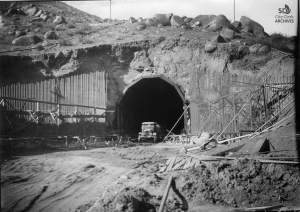
Download Image
Here is an interesting photo of the diversion tunnel at El Capitan Dam. In 1932 Tom Connelly and Wilhelm Rohl formed the Rohl-Connolly Company to bid on the construction of El Capitan Dam. After successfully winning the contract, the new joint venture completed the project in 1934. After that, the El Capitan Reservoir was created and connected to the City's water system via the El Capitan Pipeline. Located approximately 30 miles northeast of San Diego on the San Diego River, it has the largest capacity in the City's reservoir system.
Published on
November 3, 1903- Saloon Limitations
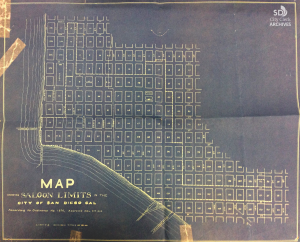
Download Image
Please look at this historical blueprint map. Here is an illustration on how many saloons were allowed to conduct business under Ordinance No. 1434, which was issued and approved by the Common Council.
Published on
June 9, 1910- First Prohibit Boxing Contest
See the application from manager of the Dreamland Pavilion asking for a permit to hold a boxing contest.
Published on
December 18, 1911 – Vending Machines
Back in 1911, the Autosales Gum and Chocolate Company inquired with the City Council for a license for vending machines. Fast forward to today, vending machines are everywhere, serving up all sorts of tasty treats and snacks! But did you know that vending machines have a really fascinating history? Coin-operated machines that dispensed tobacco were being operated as early as 1615 in the taverns of England. In 1867, stamp vending machines made their debut, and by 1883, we had the first modern postcard vending machine. The real boom, though, came between the 1920s and 1960s, when it felt like you could find just about anything in a vending machine! Honestly, there’s nearly no limit to what these machines can offer—it's only limited by our imagination!
Published on
1935 – A Genuinely International Exposition
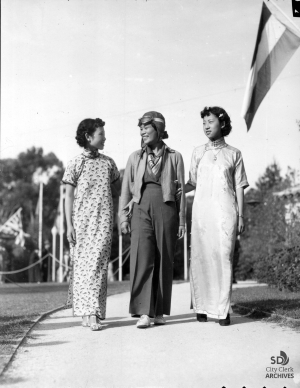
Download Image
Check out this photo of three Chinese ladies from the California Pacific Exposition in 1935! Doesn’t it capture a beautiful moment? Two of the ladies are elegantly sporting traditional cheongsams, while the one in the center looks all set for adventure in her stylish pilot outfit. The California Pacific International Exposition was held from May 29, 1935–November 11, 1935 and February 12, 1936–September 9, 1936. It was such a fantastic showcase of international culture, with ladies in traditional costume from various countries really bringing that global flair to the exhibition!
Published on
1919 – Municipal Camp Grounds in Balboa Park
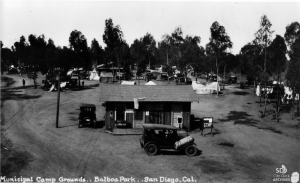
Download Image
Take a look at this amazing historic photo from circa 1919 that captures camping at Balboa Park! After serving as the site for the Panama-California Exposition from 1915 to 1917, the park became a temporary military base during World War I. Once the war was over, Balboa Park happily returned to its role as a spot for recreation and public events.
Published on
1969 - Safety First
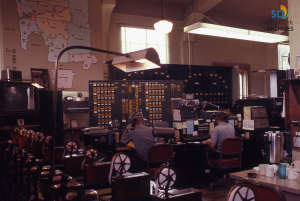
Download Image
Look at this photo of the Fire Department personnel at work in the San Diego Fire Alarm Communications Building on Marston Point. Fire Chief Louis Almgren and Assistant Chief John E. Parrish worked closely with Alarm Superintendent J. W. Collins in 1926 to design and set up a state of the art, modern fire alarm telegraph communications center. Operations started in 1928. The city moved its fire alarm communications network into the new city hall complex downtown and closed the old fire alarm station forever in 1970.
Published on
September 16, 1904 – Irving J. Gill’s Petition
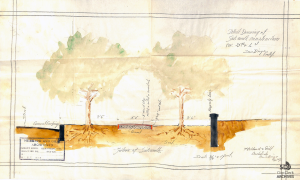
Download Image
Please review this petition submitted by Irving J. Gill to the City Council in 1904. He proposed a new method for sidewalk paving that would alter the color and appearance of traditional sidewalks. Notably, the document includes a beautiful hand-drawn design that remains remarkably well preserved even after 120 years.
Irving John Gill (1870-1936) is widely recognized as San Diego's most prominent and innovative architect. Twelve of his buildings in Southern California are listed on the National Register of Historic Places, and numerous others have been designated as historic by local government authorities. His notable works include the George W. Marston House, Maj. Myles Moylan House, Old Scripps Building, Horton Plaza Fountain, First Church of Christ, Administration Building for the Panama-California Exposition, La Jolla Woman's Club, the earliest structures at The Bishop's School, the residence of Ellen Browning Scripps, etc.
Published on
1954 - Lights, Camera, Action
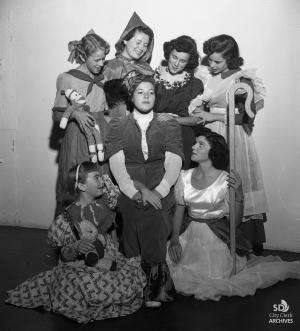
Download Image
Here is an interesting photo of seven actresses performing in San Diego Junior Theatre's performance of Babes in Toyland, including Wanda Adamson, Carolyn Parker, and Barbara Blanchard. Established in 1948 in Balboa Park, San Diego Junior Theatre is the oldest youth theatre program in the United States, producing shows acted and crewed by children ages 8-18.
Published on
1935 – Wells Fargo, San Francisco Model
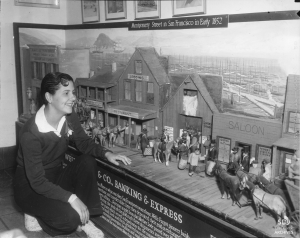
Download Image
Check out this fascinating photo from the California Pacific Exposition in 1935. It showcases a model of San Francisco's Montgomery Street back in 1852. Isn't it amazing how realistic it looks? The street is bustling with hotel, restaurant, saloon, and more. Notably, you can spot Wells Fargo & Co. — founded by Henry Wells and William George Fargo in 1852 to cater to the banking and express needs during the California Gold Rush. Such an intriguing piece of history!
Published on
1949- Take Me Out to the Ball Game
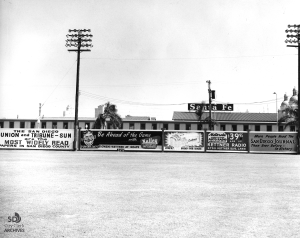
Download Image
Here is a fascinating fun fact and advertisements featured around Lane Field for Kelley Laundry, Sunbeam Bread, Kettner Radio, and San Diego Journal. In 1925, a downtown waterfront ballpark was built and name after Bill Lane. It was the home of the Pacific Coast League's San Diego Padres from 1936 to 1957. The Padres, formerly known as the Hollywood Stars, were owned by Bill Lane, who made his fortune in gold mining. The Padres moved to Mission Valley in 1958, and Lane Field became a parking lot.
Published on
1935- Scientific Experience
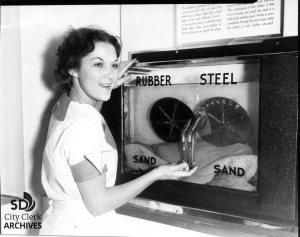
Download Image
Feast your eyes on this interesting exhibit featuring rubber and steel interacting with sand at the California Pacific International Exposition, held in May - November 1935 and February - September 1936. It was held in Balboa Park, San Diego's large central urban park, which had also been the site of the earlier Panama-California Exposition in 1915. The Exposition was held to promote San Diego and support its economy and had hundreds of exhibits on history, the arts, horticulture, ethnic cultures, science, and industry.
Published on
December 2, 1936- City Truck No.371
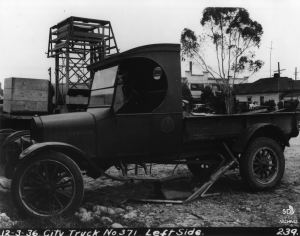
Download Image
Check out this fascinating 1936 photo of a city truck, number 371! You can even see the city seal prominently displayed on the left door. What a cool find!
Published on
February 26, 1983 - A Royal Welcome
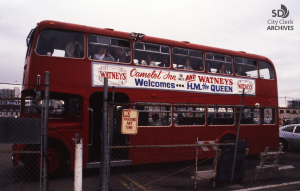
Download Image
Here is a photo of the Red British-themed double decker bus, with a banner greeting Queen Elizabeth and Prince Philip. They arrived in San Diego on the Royal Yacht Britannia for their 10-day West Coast tour in 1983, which was hosted by President Ronald Reagan. The visit was dubbed 'The Scuba Tour' because of the almost constant rain, the cities included were San Diego, Palm Springs, Los Angeles, Sierra Madre, Duarte, Santa Barbara, San Francisco, Sacramento, Stanford, Palo Alto, Yosemite, and Seattle.
Published on
1944- Deep-Sea Fishing off Coronado Island
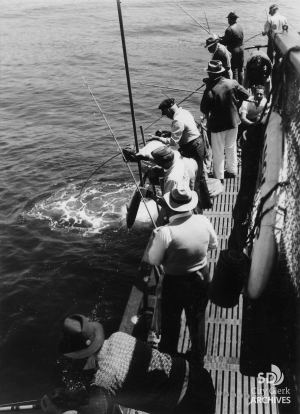
Download Image
Look at this exciting photo of several fishermen in action in 1944. They were deep-sea fishing off Coronado Island. The waters off San Diego are among the best for deep-sea fishing. Each summer, the warm waters attract a huge number and selection of fish. From 3 to 10 miles offshore, the catch includes calico bass, sand bass, white sea bass, barracuda, mackerel, and dorado. Go out 60 to 80 miles for bluefin tuna, yellowfin tuna, big eye tuna, skipjack, and yellowtail. The deeper you go, the bigger the fish.
Published on
1912 – Free Speech Fight
This document from 1912 illustrates the San Diego County Federated Trades and Labor Council's opposing an ordinance that prohibited free speech. The free speech fight in San Diego in 1912 was sparked by the city council's approval of Ordinance No. 4623 on January 8, which restricted public speaking and singing within designated areas.
Published on
1914 – A Three-Legged Race
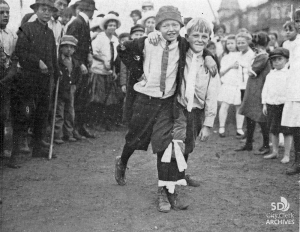
Download Image
Please take a moment to view this historical image of boys in a three-legged race at Rose Park Playground in 1914. Rose Park was located downtown San Diego at 11th and I Streets (now Island Avenue).
Published on
1887- First County Courthouse in New Town

Download Image
Here is a photo of the first courthouse that was built in 1871. The land was donated by downtown founder Alonzo E. Horton and the architect was Levi Goodrich of San Jose. The archives were moved here from the Whaley House in Old Town which was served as the courthouse since 1856. The photo was taken by Herve Friend for Douglas Gunn's 1887 book ‘Picturesque San Diego.’
Published on
1940-Naval Training Center and Lindbergh Field
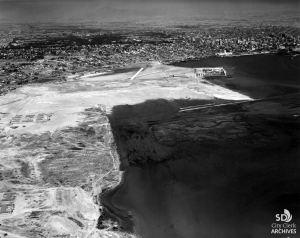
Download Image
Catch a glimpse of this bird’s eye view of Naval Training Center San Diego and Lindbergh Field. NTC San Diego was built in 1923 and Lindbergh Field was built in 1928. Now these locations are listed on the National Register of Historic Places. The base was closed by the Base Realignment and Closure 1993 Commission and is now the site of Liberty Station, a mixed-use community being redeveloped and repurposed by the City of San Diego.
Published on
August 31, 1975 - Concerts at the Balboa Stadium
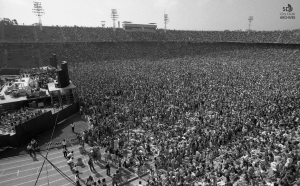
Download Image
Checkout this photo of a packed-out concert event at the San Diego’s Balboa Stadium. Fleetwood Mac, Loggins and Messina, Rod Stewart and Faces, and Lynyrd Skynyrd have performed at the infamous Balboa Stadium which was a popular 1975 venue. Other concerts that year included The Beach Boys with Jessie Colin Young and Pure Prairie League, and The Allman Brothers Band.

